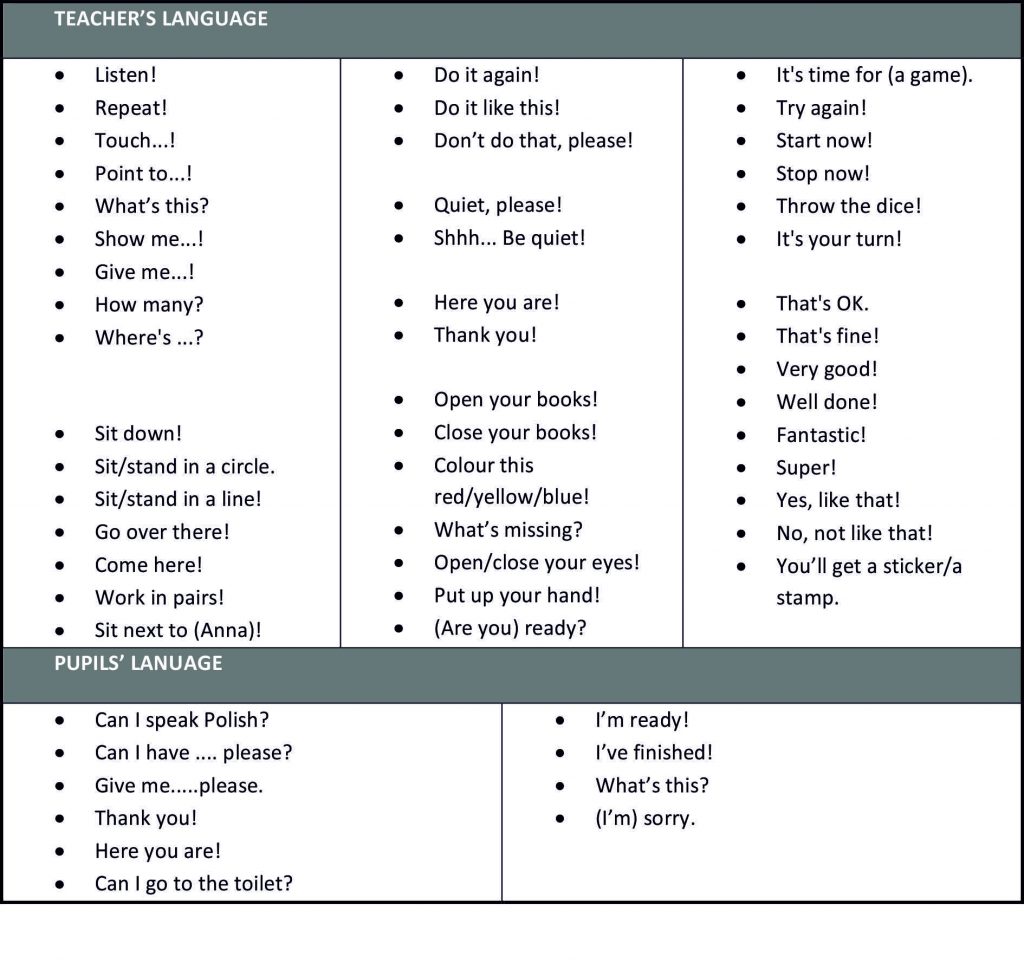In the previous article of this series (which was first published in the Teacher Magazine in 2013/14) I presented some ideas on how to use the chidren’s world of imagination to boost the motivation and make the lessons more effective and engaging. This time I am going to focus on the concept of using English and mother tongue during the lessons in YL classroom. I am going to present some opinions that we, as the authors of YL course support and have been testing in practise for the last few years.
Teachers in the YL classroom often struggle with the dilemma: English only or some mother tongue? Probably there are as many opinions on that subject as there are teachers. Definitely, using as much L2 as possible is beneficial to young students as it makes the lessons a bit closer to natural acquisition and a L2-rich lesson may contribute to L2 immersion. However, I have seen quite a few lessons when confused 4-5 year olds had no idea what they were supposed to do and what was expected of them and thus lost interest in the lesson altogether. Let’s face it: seeing your students only once or twice a week for 30 or 40 minutes (which is how long YL lessons usually last) does not really allow for any real L2 immersion and is in essence very little contact time. Is it not desirable to exploit every minute of the lesson to the full? I believe it is.
CLASSROOM LANGUAGE
And if so, the obvious question is how to use the foreign language truly effectively.My answer is that we should always support our instructions with non-verbal actions. They will be easier to understand. Let’s think back to how parents talk to their babies in their mother tongue. They use ‘caretaker speech’ to make it easier for children to understand. Below you will find some characteristics of such speech which might be used by English teachers:
– Short sentences
– Slower rate of speech
– Repetitions
– Simple structures: active verbs, no subordination
– More questions and commands
– Nouns rather than 1st or 2nd person pronouns: “mummy’s here” / “teacher will do it”
– “Here and now” topics (commenting on what you can see) and topic areas immediately relevant to the child such as the family, home environment, toys, animals, body parts, and food.
– Exaggerated intonation patterns
– Adjustments to pronunciation
It is certainly a good idea, especially at the beginning, to use short sentences and simple language. To monitor oneself, it is advisable to prepare a CLASSROOM LANGUAGE CHART and keep it at hand (below you will find a sample ready-to-use CHART). We can mark the phrases that we have already introduced on the chart and try to use them as often as possible. It is important to use these phrases as much as possible during games and other class activities. And there is no reason why we should restrict ourselves to using only simple and set phrases throughout the course. If you see that your learners understand you, talk to them using longer and natural sentences. The goal is to make children understand the natural, everyday language.
Another strategy is to require a non-verbal reaction from your learners (e.g. stand up, clap their hands and so on). When you are not sure if they have understood, ask them in L1 or help by showing them what to do. Do not resort to L1 immediately when you can see that only some students have understood and the rest simply follow their actions. Since the language is often connected with movement, students who have not comprehended a given utterance will copy the other children’s actions first, but gradually they will learn as well. Use all the visual aids, pictures, toys to support comprehension. Both real objects and pictures draw children’s attention, help to remember, stimulate imagination and help them to grasp the meaning.
Get your children motivated to use a given phrase ‘transactionally’ e.g. ‘you will get a crayon if you ask me in English’. Below, in the CHART you will find some examples of the classroom language, which children should master.
When your students are familiar with the classroom phrases and they have no problems with understanding your instructions and commands you may try to make them “take over” and play the part of the teacher in some games or activities. I described this process in detail HERE. Now I would like to present one additional idea.
ABRACADABRA, YOU ARE THE TEACHER NOW! – A GAME!
prepare: flashcards with activities
the procedure:
Students revise the phrases “I like…” and “I don’t like…” Students sit in the circle and the flashcards activities are placed in the middle. Teacher calls out the students in random order.
Teacher: It’s your turn now, Monika. Pick a card.
Monika: I like drawing.
Teacher: Thank you. Very good. It’s your turn now, Tomek. Pick a card.
Tomek: I don’t like running.
Teacher: Thank you. Very good. It’s your turn now, Basia. Pick a card.
……
When you keep repeating the same phrases students will remember them in no time. Now: reverse the roles.
Teacher: Abracadabra! Tomek is the teacher now!
Tomek: It’s your turn Kasia. Pick a card.
Kasia: I like swimming.
Tomek: Thank you. Very good. It’s your turn now, Zuzia.
…..
Teacher takes the role of a student for some time, however, it is still the teacher’s role to scaffold weaker students and help when needed.
WHAT ABOUT THE MOTHER TONGUE?
If you teach complete beginners, you will be forced to use some more mother tongue during the first few weeks of the course, but it should be limited in time. The aim in my opinion is to use English in class about 90% of the time. It does not mean though that the mother tongue should be totally eliminated from the lessons – actually it can be quite beneficial, because:
- speaking in L1 comes naturally to all of us, particularly to young children. Allowing kids to be themselves makes them feel safe. We cannot deprive them of their identity, possibility to express themselves and show interest in what they are doing.
- using L1 is the best way to confirm that students understand thoroughly the meaning of a language item in L2. It is important at the presentation stage and when a student clearly misunderstands something or misuses a language item.
STUDENTS SPEAK THEIR MOTHER TONGUE
There are some situations when it may be beneficial for you students to use mother tongue, including those below:
- when they tell you what they understand of a story/song/rhyme, etc. You may allow for some answers in L1, especially with younger and less advanced students.
- when they need to express themselves on matters related to the lesson
- if you feel that a child) has a strong urge to tell you something
VIP & “A POLISH MOMENT”
There are lessons when students are very excited and almost explode trying to share some Very Important Personal informationwith you and they are not able to express it in L2 yet. I always try to use two techniques. One, used with more advanced pupils, is to forbid them to use Polish and encourage them to use English to express what they want, at the same time scaffolding and giving necessary clues. For example:
Student: Proszę pani a ja mam tutaj… 
Teacher: Oh! We cannot speak Polish here, can we?
Student: Ale ja nie potrafię…
Teacher: Let’s try, I will help you.
Student: I…. I…. tooth…. blue… mam kolorową plombę!
Teacher: Wow! You have a blue filling, yes?
Student: Yes!
Teacher: Repeat: I’ve got…
Student: I’ve got… a blue… tooth!
Teacher: Well done! You said it in English!
The other technique I use with younger pupils is when I notice that most of them are really excited and they cannot focus on the activities. I organize a “Polish moment”. After explaining to students that they can speak their mind now, in Polish, I set an alarm clock (I always use my mobile phone) and announce that they can only use Polish till the buzz goes off. Then we switch back to English again. This technique takes the steam go off the students, releases tension, and lets you easily go back to the main course of the lesson.
TEACHER SPEAKS THE MOTHER TONGUE
If you are not a native speaker you may struggle with the doubts concerning whether you should use English only or let yourself resort to mother tongue from time to time. I would argue that while working with young learners some L1 moments are inevitable. What are these moments?
- during presentation of new language items or preparation of a new activity, e.g. when it is necessary to explain a complex game or play, which would be beneficial only when understood correctly.
- in a management crisis, especially when you can see tears or you feel that children, especially the small ones, need support, cheering or a hearing out. Also when you are forced to reprimand a child (if the child disturbs the lesson, destroys something, or hits other students). When the whole group misbehaves and you need to calm them down – use L1 with a serious voice, then switch to L2 and also change your tone (English will be associated with positive reinforcement).
- when confirming comprehension: in some cases it is good to use mother tongue to confirm understanding of texts or phrases, especially when introducing new ones. Be careful not to overuse L1 though
- when setting a goal for an activity – sometimes you may ask a pre-listening question in L1 to raise interest and give your students a clear goal for listening (to answer the question they have to understand English anyway)
- occasionally, when it is impossible to create an atmosphere of mystery and suspense in English, you may want to use L1. Using L1 may help you focus your students and raise their interest.
- when relating to the children’s lives (occasionally and always with a time limit in mind): make sure you implement at least some ideas in L2. Such occasions can be the best opportunities for real communication.
ENGLISH TIME
With all the above examples on how L1 can be valuable and when it could be used to benefit the students, a question worth asking is: should the teacher try to introduce time when L2 only is spoken? In my opinion: YES! Otherwise students will not try to use English for meaningful communication. They will perceive it as something practised during activities but not as a means of expressing what they want to communicate. It is also one of the ways to reduce their chatting in L1. It also allows for better concentration and keeps them from disturbing and distracting others.
HOW TO DO THAT?
- First, you have to explain the ‘English time’ rule to your students. They need to know that they are learning English and if they try to use it and remember not to speak L1 they will be rewarded. Their parents will also be proud and the class mascot will be happy because it will be able to understand them.
- You should use the ‘English time’ command every time children tend to speak Polish too much, especially on topics not connected with the lesson. Show them that the same rule applies to you. When you finish explaining something in Polish say, “Shh, no Polish!” and turn to English.
- When a child starts chatting in Polish and cannot stop, use a simple trick: listen for a while, show interest, but after that show that you “zip” the child’s mouth and remind of ‘No Polish’ rule.
- Act out a lot with the class mascot showing that it does not understand, feels excluded and ignored when they speak Polish, hides behind teacher’s back, cries etc.
- There are also playful ways to motivate students not to use Polish (I presented some in the previous article of the series)
you need:a cut-out robot watch(you can use the model from below)
optional:flashcards with activities
general comments:
This is a great opportunity for your students to take over and start giving their own commands to others. It is also a way of showing them that English is acceptable during the lesson, whereas Polish “does not work.”
Support students and let them speak freely even if some of their ideas are strange or language is inaccurate. This is the shortest way to come up with some real communication.
how to play:
- Students put the robot watches on their wrists.
- Teacher explains that the robots were imported from England / the USA and they cannot react when Polish is spoken to them – they do not understand.
- Student A presses buttons on student’s B watch with his/her index finger pretending to insert a password/code.
- Student A says with a robot-like voice: Brush your teeth! and student B (who’s been “programmed”) must pretend to brush his/her teeth. Then the roles are reversed.
- Stick some flashcards with activities to the board/wall to give students more ideas of what to say.
the robot watch:
CLICK FOR THE NEXT EPISODE OF THIS SERIES.
If you like this article, let us know! Comment, like or share! Thank you!




